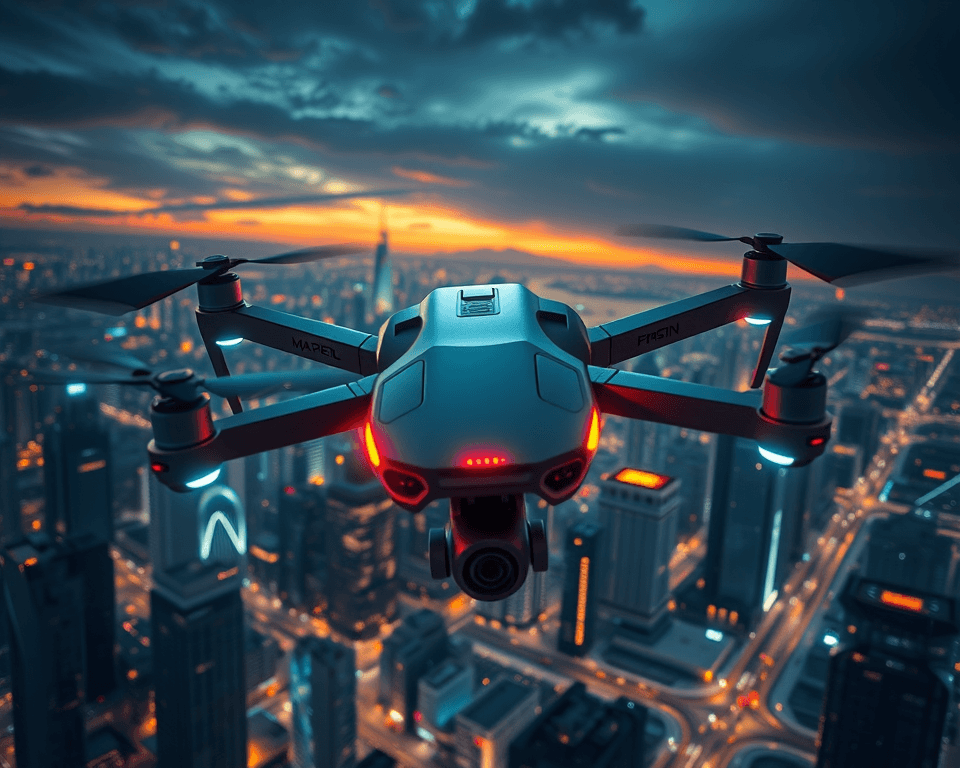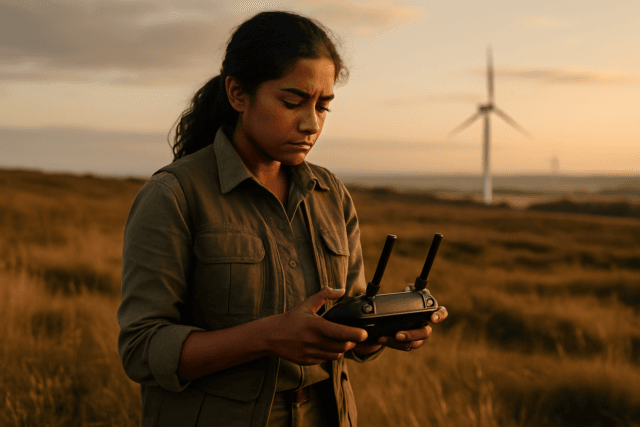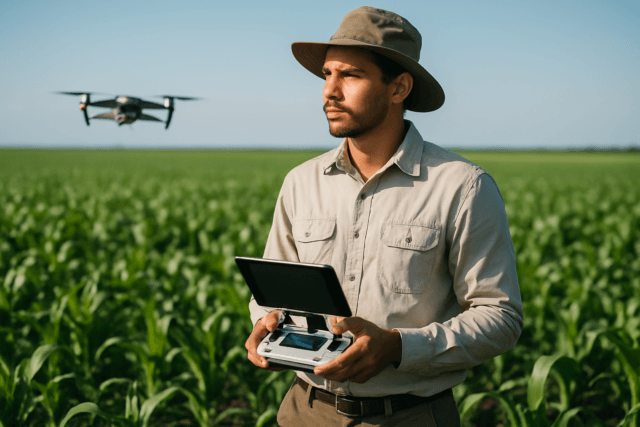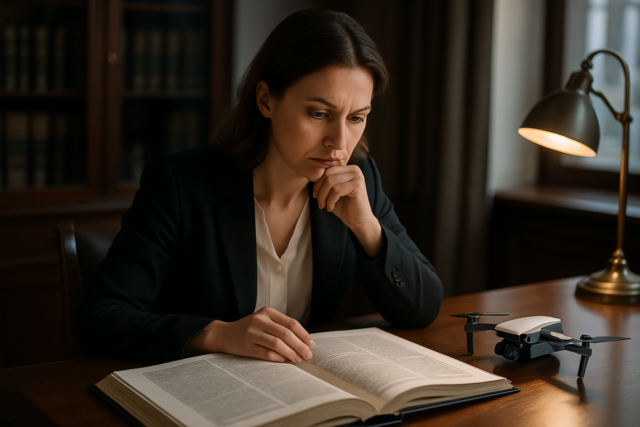Drones, also known as unmanned aerial vehicles (UAVs), have become increasingly popular in recent years. These versatile machines are used in various fields, including agriculture, construction, filmmaking, and surveillance. But how do drones work? This comprehensive guide explores the inner workings of drones, their components, types, and applications.
What is a Drone?
A drone is an unmanned aircraft that can be remotely controlled or fly autonomously using software-controlled flight plans in its embedded systems. Drones combine robotics with aeronautics and are equipped with modern technologies such as GPS, radar control, infrared, and high-resolution cameras.
Core Components of a Drone
Drones consist of several key components that enable them to fly and perform various tasks. These components include:
- Frame: The frame is the main structure of the drone, typically made of lightweight and strong materials like plastic or carbon fiber. It houses and protects the other components.
- Motors: Drones use electric motors to spin the propellers. Brushless motors are more efficient and durable than brushed motors.
- Propellers: The shape, size, and number of propellers determine the drone’s speed and lifting ability. Two propellers rotate clockwise, while the other two rotate counterclockwise to maintain balance.
- Electronic Speed Controllers (ESCs): ESCs connect the battery to the electric motors and control the speed of each motor based on commands from the flight controller.
- Flight Controller (FC): The FC is the central processing unit of the drone. It takes inputs from sensors and the pilot’s commands to control the motors and maintain stable flight.
- Sensors: Drones are equipped with various sensors, including:
- Gyroscopes: Detect changes in orientation.
- Accelerometers: Measure changes in velocity and direction.
- Magnetometers: Measure the strength and direction of the magnetic field, acting as a compass.
- GPS: Provides precise location information.
- Barometers: Measure altitude.
- Ultrasonic Sensors: Detect obstacles and measure distance.
- Radio Transmitter and Receiver: The transmitter sends radio signals to the drone, while the receiver receives signals from the pilot.
- Battery: High-capacity lithium polymer (LiPo) batteries are commonly used in drones due to their high energy density and light weight.
- Camera: Many drones have an onboard camera that streams real-time video to the pilot.
- Gimbal: A gimbal is a pivoted support that allows the camera to rotate on different axes, keeping it stable even when the drone is moving.
How Drones Fly: Principles of Flight
The physics behind drone flight involves aerodynamics, propulsion, and control.
Aerodynamics and Lift
- Rotary Wing Drones (Quadcopter): Most common drones, like quadcopters, use multiple rotors to generate lift. Each rotor consists of a motor and a propeller. When the propellers spin, they create a downward thrust by pushing air downwards, which in turn generates an upward lift force, allowing the drone to hover, ascend, or descend.
- Fixed Wing Drones: These drones operate more like traditional airplanes, using fixed wings to generate lift. They require forward motion, provided by a propeller or jet engine, to create airflow over the wings and generate lift. As the drone moves forward, the air flowing over the wing creates a lower pressure area above the wing and a higher pressure area below it, resulting in an upward force known as lift.
Propulsion
Drones use propellers or rotors powered by an electric motor or internal combustion engine to generate thrust and move forward. The spinning of the propellers creates a forward force, known as thrust, which propels the drone forward.
Control
Drones use control surfaces and advanced sensors to stabilize and navigate flight. The flight controller adjusts the speed of each motor to control the drone’s movement. By varying the speed of the rotors, the drone can move forward, backward, and side to side.
Flight Control System (FCS)
The Flight Control System (FCS) is an essential component in both manned and unmanned aerial vehicles (UAVs), including drones. The FCS consists of various hardware and software components designed to control and stabilize an aircraft during flight.
Components of FCS
- Orientation and Motion Sensors: The Flight Control System (FCS) relies on a suite of sensors, such as gyroscopes, accelerometers, and magnetometers, to measure the drone’s orientation, angular velocity, and movement.
- Position and Altitude Sensors: The FCS uses GPS for accurate positioning, barometers for altitude measurement, and ultrasonic sensors for close-range height detection.
- Flight Controller: The flight controller is the central unit that processes data from all sensors.
- Electronic Speed Controllers (ESCs): Synchronize motor operation for stable and responsive flight.
Core Functions of a Flight Controller
- Stabilization: The flight controller ensures the drone maintains stability in flight by continuously adjusting the motor speeds based on the feedback from onboard sensors.
- Movement Control: The flight controller interprets the input from the remote control or the onboard computer, translating it into motor actions to move the drone in the desired direction.
- Telemetry: The flight controller often manages telemetry data, sending flight data such as altitude, speed, and GPS coordinates back to the operator.
Navigation and Positioning
- GPS: Many drones use GPS to navigate and maintain their position, enabling features like waypoint navigation and return-to-home functions.
- Obstacle Detection and Avoidance: Advanced drones are equipped with sensors that detect obstacles in their path and adjust their flight path to avoid collisions.
Communication Systems
Drone communication systems are crucial for maintaining control, transmitting data, and ensuring mission success.
Primary Functions
- Control and Command: Allows the operator to pilot the drone.
- Data Transmission: Transmits critical data, such as GPS coordinates, telemetry, and video feeds.
Primary Components
- Controller: The main interface between the drone and its operator.
- Transceiver: Maintains two-way communication between the drone and the controller.
- Antenna: Integral to both the controller and the drone for transmitting and receiving signals.
- Onboard Flight Control System (FCS): The “brain” of the drone.
Common Radio Frequencies
- 2.4 GHz Frequency Band: The most widely used band for consumer and commercial drones.
- 5.8 GHz Frequency Band: Commonly used for high-definition video transmission, especially in FPV (First-Person View) systems.
- 900 MHz Frequency Band: Valuable for drones operating in environments with heavy interference or where a greater range is needed.
Types of Wireless Communication Platforms
- Commercial RF (Radio Frequency): The most commonly used drone communication system, but limited to line-of-sight operations.
- Cellular (4G and 5G): Offers decent area coverage, including for BVLOS operations, but limited outside of urban areas.
- Ethernet SDR (Software Defined Radios): Provides excellent coverage, bandwidth, and uptime across applications.
Power Systems
Drones can be powered by various sources, including batteries, fuel, solar, and hybrid systems.
Types of Drone Power
- Battery-powered (electric): These UAVs use rechargeable batteries, offering quiet operation and lower maintenance but potentially limited flight times.
- Fuel-powered (internal combustion): Utilizing traditional fuels like gasoline or diesel, these UAVs often have longer flight times but may be noisier and require more maintenance.
- Hybrid: Combine a fuel combustion engine with batteries for greater flight time.
- Hydrogen fuel cell: Offers long flight times and quick refueling.
- Solar-powered: Uses solar panels to generate electricity.
Electric Power System Components
The electric system of an electric drone mainly includes a motor, an ESC, a propeller, and a battery. Batteries are generally high-rate lithium polymer batteries, which are characterized by high energy density, light weight, and high current resistance.
Drone Payloads
A drone payload is the total weight of the equipment and cargo it can carry in addition to its own weight. This can include cameras, sensors, delivery packages, or any other tools necessary for a specific application.
Common Payload Types
- Cameras: Used for photography, videography, surveillance, and inspections.
- Sensors: Including thermal imaging, LiDAR, and multispectral sensors for environmental monitoring and agriculture.
- Delivery Mechanisms: For delivering packages or other items.
- EO/IR sensors (electro-optical/infrared): Provide functions such as mapping, target acquisition, threat detection, and object tracking both during the day and at night as well as through smoke and haze.
Payload Capacity
The payload capacity of a drone depends on its size and its power-to-weight ratio.
- Toy Drones: Typically lightweight with a payload of less than 0.5 kg.
- Consumer Drones: Suitable for photography and videography, usually carrying lightweight cameras (up to 2-5 kg).
- Commercial Drones: Used for agricultural monitoring, surveying, and inspections, carrying payloads of 5-25 kg.
- Heavy Lift Drones: Designed for carrying large payloads (25 kg and above), used in construction, delivery services, and industrial applications.
Types of Drones
Drones can be classified based on their design, size, power source, or use case.
- Multi-Rotor Drones: These drones have multiple rotors and are popular for aerial photography and surveillance. Common configurations include tricopters (3 rotors), quadcopters (4 rotors), hexacopters (6 rotors), and octocopters (8 rotors).
- Fixed-Wing Drones: These drones have fixed wings like traditional airplanes and are efficient for long-distance flights, aerial mapping, and surveillance.
- Single-Rotor Drones: These drones use a single main rotor and a tail rotor for stability and control.
- Fixed-Wing Hybrid VTOL Drones: These drones combine the features of fixed-wing and multi-rotor drones, allowing for vertical takeoff and landing (VTOL) and efficient forward flight.
Advantages and Disadvantages of Drones
Advantages
- Cost-Effective: Drones are cheaper and easier to deploy than manned aircraft.
- Accessibility: Drones can fly to areas that would be difficult or impossible to access for humans.
- Versatility: Drones can be equipped with various payloads for different applications.
- Improved Safety: Drones can access hazardous or hard-to-reach areas without putting human workers at risk.
- Increased Efficiency: Drones can perform tasks more quickly and efficiently than traditional methods.
- Data Accuracy: The high-resolution data collected by drones offers more precise measurements and higher-quality surveying and mapping outcomes.
Disadvantages
- Limited Flight Time: Drones have relatively short battery lives, typically ranging from 15 to 30 minutes.
- Weather Dependency: Strong winds, rain, or extreme temperatures can affect drone flights.
- Regulatory Challenges: The use of drones is subject to various regulations and restrictions.
- Privacy Concerns: Drones equipped with cameras can capture sensitive data and images, raising privacy concerns.
- Safety Risks: Drones can cause damage to property and injury to people if not operated properly.
- Data Transfer Speed is Slow: One of the cons in expanding drone technology in precision agriculture is its data transmission speed, which some suppose could be a week.
Drone Regulations in the UK
In the UK, drone operations are regulated by the Civil Aviation Authority (CAA). Key regulations include:
- Registration: You must register with the CAA before flying most drones outdoors in the UK. If you fly, you must pass the DMARES theory test to get a flyer ID; if you’re responsible for a drone, you must register for an Operator ID and then label the drones with this ID.
- Visual Line of Sight (VLOS): Keep the drone within Visual Line of Sight (VLOS). If flying using first-person view, you must have a competent observer next to you who maintains VLOS with the aircraft.
- Maximum Height: Do not fly higher than 400 ft (120 metres) from the earth’s surface.
- Distance from People: Depending on which category of drone you’re flying you may need to stay at least 50m away from crowds and other people, and 150m away from built-up areas.
- Restricted Airspace: Don’t fly in Restricted Airspace, for example near aerodromes, unless you get permission.
- Privacy: Respect other people’s privacy, and know what you can and cannot do with photos and videos.
- Labeling: Label your drones with your operator ID.
- Flyer ID: Anyone flying a drone that weighs over 250g must pass a basic test with the CAA to get a FlyerID and carry their FlyerID details at all times while flying.
Applications of Drones
Drones have a wide range of applications across various industries:
- Agriculture: Monitoring crops, assessing plant health, spraying pesticides and fertilizers, and managing water resources.
- Construction: Surveying and mapping land, creating 3D models, inspecting structures, and monitoring environmental impact.
- Filmmaking: Capturing aerial footage and dynamic tracking shots.
- Search and Rescue: Providing an aerial view of disaster zones and assisting in search operations.
- Surveillance and Security: Monitoring traffic, providing security for events, and conducting border surveillance.
- Delivery Services: Delivering packages and medical supplies.
- Military: Intelligence, surveillance, and reconnaissance.
- Infrastructure Inspection: Inspecting bridges, power lines, and other infrastructure.
- Environmental Monitoring: Monitoring wildlife, forests, and other natural resources.
- Firefighting: Enhancing situational awareness, safety, and efficiency in firefighting operations.
The Future of Drone Technology
As technology advances, drones are expected to become even more versatile and capable. Future developments may include:
- Improved battery life and flight time.
- More advanced sensors and payloads.
- Increased autonomy and artificial intelligence.
- Expanded use in urban environments.
- Integration with other technologies, such as virtual reality and augmented reality.
Drones have revolutionized many industries and changed our daily lives. They are complex machines that rely on various components and principles of flight to operate effectively. By understanding how drones work, we can appreciate their capabilities and potential for future applications.





